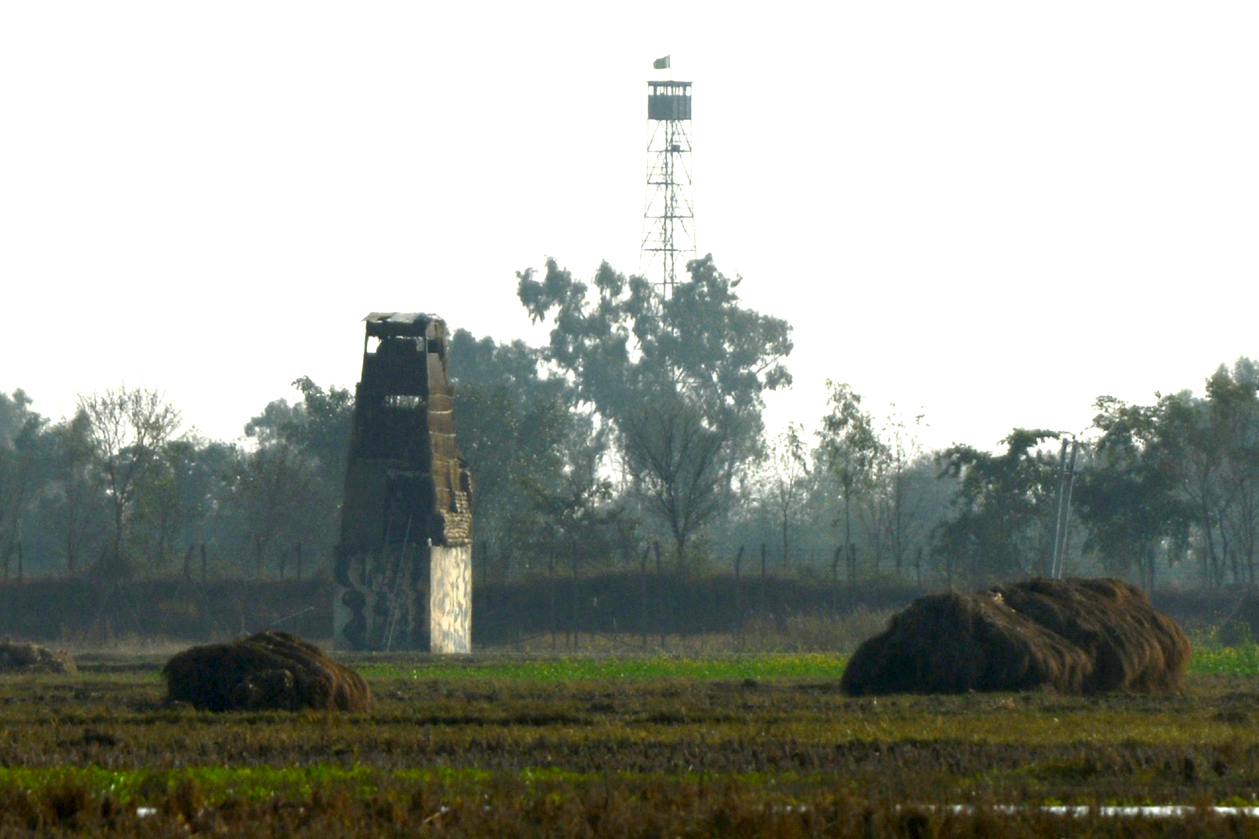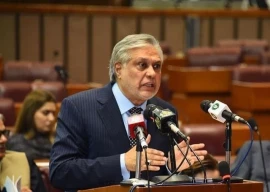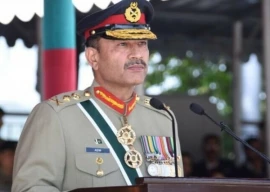
The rancid smell of gunpowder has a strange habit of overpowering the fabled fragrance of peace. Something similar is happening across the geographical line that separates Pakistan and India.
In November 2003, the two hostile neighbours agreed to a ceasefire on the Line of Control (LoC). Surprisingly, guns remained silent for almost a decade. Then suddenly in January this year trouble started. The delicately held ceasefire began to creak at the hinges as bullets and shrapnel developed a mind of their own, snuffing out lives and cracking open structural abodes.
Since then, the situation has worsened. Last week saw heavy exchange of firepower across the working boundary in Sialkot. Earlier, Pakistan summoned the Indian High Commissioner in Islamabad to the Foreign Office and gave him a dressing down. Across the LoC, the Indian Home Minister toured the border villages in Occupied Kashmir and fired off a verbal warning to Pakistan. The carefully constructed and nurtured peace narrative, it seemed, had begun to unravel.
What happened? Explanations vary. “Indian belligerence is definitely linked to their domestic politics,” says a senior Pakistani official involved in formulating Pakistan’s India policy. “Election fever and Narinder Modi’s Pakistan-bashing is deconstructing Indian narrative towards us,” he says.
This may be one reason, but clearly there are other factors at play. Pakistan-India ties are usually hostage to the prevailing mood and political environment in both countries. Add to this the Afghanistan cauldron and throw in the US troops withdrawal from the region next year and things get even more complicated. But none of this is breaking news. Modi’s vitriol does not come as a surprise. Leading the BJP charge against the corruption-tainted Congress government, Modi has been blasting the outgoing Indian Prime Minister Manmohan Singh of being soft on Pakistan, and has also begun to target Rahul Gandhi in his speeches. As campaign fever builds up towards next year’s general elections, Pakistan will become the favourite whipping boy and each candidate will try and outdo the other in vowing to “teach Pakistan a lesson”.
On our side, Prime Minister Nawaz Sharif appears to be bending over backwards to reach out to India. During his US visit he lost no opportunity to gloat over his peace credentials, using every speech, every interview and every meeting to emphasize his desire to resolve outstanding issues with India. But times do not appear propitious for any grand peace initiatives. Sharif may desire what Gen Pervez Musharraf did, but he does not as yet have the leverage over State policy as Musharraf did. It was between 2004 and 2007, when Musharraf held complete sway over national policy, that Pakistan and India came closer than ever to resolving their issues including Kashmir. Officials say backchannel negotiations between Tariq Aziz and India’s S K Lambha produced surprising headway on all disputes. An Indian official was quoted as saying in 2009 that the two countries were on the verge of making a “historic” announcement. But then Musharraf dismissed Chief Justice Iftikhar Chaudhry and the rest, as they say, is history.
Musharraf left, but the LoC ceasefire held. Gen Ashfaq Kayani had been DG ISI under Musharraf and was in the loop on the back channel developments. His tenure as army chief was defined not by the traditional India-centric approach, but by an emphasis on Afghanistan and terrorism. The weak PPP government took no initiative on India, or for that matter on any other foreign policy issue, preferring to outsource all this to army high command. With the change of guard in the army in the offing, no major course correction can be expected on India by the new government. A lot will depend on the gentleman who succeeds Gen Kayani in November.
So we return to the original question: why are the guns booming again? Is it the hardliners on both sides sending a signal to the peaceniks? Is it the Indian Establishment flexing its muscles ahead of the US withdrawal from Afghanistan next year? In the cloak-and-dagger games that define Pakistan-India ties, it is near impossible to say anything with certainty. Instead, the only certainty right now is the zero chance of concrete peace initiatives from either side, like the resumption of the composite dialogue process. The best that can be done is to not let the situation escalate further, and manage the acrimony till the dust settles in Islamabad and New Delhi. Hold the fire, but don’t hold your breath.
Pak-india tension: Worst skirmishes in a decade
With over 50 violations across the Line of Control and working boundary, tensions have been escalating between Pakistan and India.
Both the countries blame each other for violating the decade-old ceasefire. Skirmishes since the start of the year have taken the lives of many, including civilians. Starting from the LoC in Poonch sector, the firing has moved to the working boundary in Sialkot sector. The prime ministers of both the countries have condemned the flare-up but have so far failed to help silence the guns.

Source: Pakistani, Indian and independent newspapers
Aug 5/6:
Poonch area Kamalkote Sector of Uri town in Baramulla District
Aug 8:
Chak Faqira belt, Samba Sector of Samba District Tatta Pani sector
Aug 10:
Poonch District
Aug 11:
Kanachak belt of Jammu District Balakote, Mendhar and Mankote Sectors in Poonch District Digwar village of Poonch District Poonch District
Aug 12:
Battal, Chirikot and Satwal sectors
Aug 14:
Keran sector of north Kashmir Khairni Rakkar village of Rawalakot district in Battal sector
Aug 15:
Kotli, Azad Kashmir Poonch sector
Aug 18:
Nakyal sector AJK’s Kotli district Mendhar sub-sector of Poonch district
Aug 19:
Hamirpur and Balakote border belts in Poonch Mankote and Mendhar belts
Aug 19:
Hamirpur and Balakote border belts in Poonch Mankote and Mendhar belts
Aug 21:
Shaqma Sector, near Skardu
Aug 22:
Rakhchakri Sector, Rawalkot; and Poonch
Aug 23:
Balnoi village near Poonch District
Aug 24:
Trikundi Gali and Balakot, Rajauri Districts; and Poonch
Aug 25:
Nakyal Sector, Kotli
Aug 26:
Nakyal Sector, Kotli
August 27
Nakyal sector
August 30
Pallanwala area, sub-sector in Jammu district
September 2
Nakyal Sector, Kotli district
October 4
Kotli area
October 11
Nakyal sector, Kotli district
October 15
Kotli area
October 17
Sialkot sector
October 19
Sialkot sector
October 21
Janglora, Sialkot sector Harpur, Sialkot sector Dhamala, Sialkot sector
October 22
Pukhlian, Sialkot sector Charwah, Sialkot sector Chapar, Sialkot sector
October 24
Bajwat Charwah, Sialkot sector
October 26
Charwah, Sialkot sector
Published in The Express Tribune, October 28th, 2013.
COMMENTS (5)
Comments are moderated and generally will be posted if they are on-topic and not abusive.
For more information, please see our Comments FAQ











1732012115-0/Untitled-design-(14)1732012115-0-270x192.webp)
1736844405-0/Express-Tribune-(2)1736844405-0-270x192.webp)










The notion that Nawaz is bending over backwards for peace is unsupported by actions on the ground. Words - especially of a country like Pakistan who has a habit of breaching their commitments mean little. When Pakistan is unwilling to schedule a face to face meeting between the two DGMOs a whole month after the PMs of the 2 countries agreed to it, no one takes Nawaz seriously.
Also 26/11 had happened just before last election and Congress had taken a soft stance. Did I lose the election? No. Barring attacks on our soldiers or our people, Pakistan is no part of our national discourse and I cannot think of a single election where Pakistan bashing ensured victory although this theory is widely echoed in Pakistan's media which is just an echo chamber.
@Usman: The million strong army reports to he defense minister in aindia. Does not bypass him like Pakistan where poor muqtar Ahmed had o follow CNN to find out what was happening during Abbotabad raids.
While they influence defense policy through the defense minister just as foreign secretary influences foreign policy and Reserve Bank governor influences finance policies that is all they can do. The army does not own the foreign policy or security policy of the country.
@Indigent: There is no Indian Establishment? Are you for real? What is the milliion strong Army doing in India if not creating chaos in all its neighbouring countries, destablising peace talks and indulging in one failed defence project after the other? The same establishment that didn't bat an eye lid sacrificing millions of Bengalis on the alter of 'break-Pakistan' in '71, the same establishment that all Indian newspapers are afraid of? When was the last time you saw a critique of the Indian Amry or any one of its Generals in an Indian newspaper? That's right, never. . The one thing you did get right, Pakistani Establishment is indeed much more powerful that its Indian counterpart, and don't you forget it.
Your "analysis" failed to mention one little fact. India alleges that Pakistani troops initiate firing to give covering fire to terrorists trying to infiltrate. Identical allegations have been made by Americans against Pakistani troops in Afghanistan. However complaints ceased when a Nato gunship "accidentally" blew away some Pakistani soldiers who were allegedly giving covering fire to terrorists.
@Author: Yes, Pakistan is the gift that keeps on giving.
Is it the Indian Establishment flexing its muscles ahead of the US withdrawal from Afghanistan next year?
Firstly, it may come as news to Pakistanis that there is no Indian "Establishment". The Army Chief is subservient to the Prime Minister, the Defence Minister and the Defence Secretary.
Secondly, why would India fire mortars across the LOC to flex its muscles on Afghanistan, a country that is hundreds of kilometers away? India already has a presence in Afghanistan at the request of the Afghans themselves.
Yes, there is a connection to Pakistan and that has to do with the Pakistani establishment which is much more powerful than its Indian counterpart. To Indians, it brings back memories of Kargil. Pakistani firing at the LOC provides covering fire for infiltrators into Jammu & Kashmir and they are repulsed by Indian firing. This all seems to be a ploy to heat up Jammu & Kashmir in time for the 2014 US withdrawal so that Kashmir can be dragged into any agreement with the US for a return route for their logistics.
Peace has to be established on the LOC if any forward movement in relations has to happen. The situation is worrisome because the Indian Army under full civilian control and without any Power, has now been given operational freedom to act as they see fit, in response to provocations. This makes the equations on the LOC very different from what it ever was, a factor not taken into account by the strategic analysts in Islamabad. The Indian Army even during Kargill was so constrained by the Government with no freedom to cross the LOC, they had to take heavy casualties. Now they seem to have been freed from the yoke, making them both accountable and responsible. Would definitely not like to be a Pakistani soldier on the LOC, considering India has the greater firepower and retaliation would be at a higher degree. Indian Military now believes that adventurism will only subside if the losses inflicted are heavy and compounded. They are no longer taken in by any differentiation as claimed by Pakistan -- these are civilians, these are non State actors, these are trouble makers, these are our forces. Now everybody is placed into the same basket, without bias or differentiation. Talking in English does not seem to have helped the Indo / Pak interlocutors, now the language on the LOC is one which even a third class Military can understand. Very sad matters had to deteriorate this far.